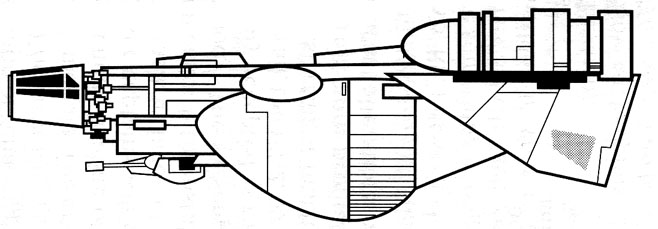
|
The Z-10 Seeker is valued for its low cost, high top-end, and superior manoeuvrability. It is especially popular in the Outer Rim Territories, where technological advancements are not as rapidly deployed as in the Core Worlds. This craft came onto the market some time before the Battle of Yavin. Many large private investors employ these craft in some capacity, and several underground organizations have their own wing of Z-10s for personal couriers. This design was Starfeld Industries' first entry into the starship market. The company believed it could easily design a craft to replace the ageing Vangaard Pathfinder and as such it was marketed as a scouting/trade ship, since the Z-10 was originally slated to fulfil a major role in the scout force. Enterprising traders keeping tight schedules, and avoid navigational and predatory delays would find the Z-10 to be an excellent option due to its superior agility, high realspace and hyperspace speed, and low crew overhead needs.
The Z-10 was built around the hypothesis that the craft's pilots would seek to outrun trouble rather than confront it. As a result, complex weapon systems were not installed to keep the ship as manoeuvrable as possible and to keep it inexpensive. The cargo pods (come equipped with standard life support connections and an airlock collar) which are attached to the main fuselage via therma-bonders can be jettisoned from the cockpit to increase the Z-10's manoeuvrability and speed (many couriers operate their ships without the cargo pods). Due to its low mass design certain elements had to sacrificed. Original design specifications called for no shield generator, which was widely regarded as a mistake, since its autoblaster and hull plating do not provide adequate protection. Mounted beneath the main fuselage, the autoblaster has a forward firing arc of 21 degrees.
In an effort to make the autoblaster affordable, BlasTech cut corners which resulted in a low damage capability for the weapon, which severely limited the number of designs the Z-10 could engage and survive against. Lacking its own targeting system to save on space and cost, the autoblaster relies on the Fabritech sensor array to provide targeting data. As a result, this set up is not as effective as a dedicated fire control system, however it does allow the Z-10 to have one of the lowest delivered costs in the space transports market. Should the Z-10 lose its sensors, its autoblaster loses its aiming ability. Conversely, should the autoblaster is damaged, the sensor package tends to shut down due to targeting computer feedback.
Most of the Z-10's systems are inter-dependent on one another, and they must be all compatible with the Miradyne flight control computer, which is notoriously picky about modifications. Unfortunately, the company which produced the flight control computer folded two years after it introduced the RCS-6 which saw use in the Assault Gunboat. Only the most advanced starports possess RCS-compatible parts in stock. Further compounding that, the RCS computers enforce a rigid set of inter-connectivity protocols. These electronic standards specify how data is to be shared between the computer and its dependent systems. Should this data not be in strict compliance with these protocols, the connected systems will either operate unreliably or fail altogether. Engineers refer to this craft as a "tight design" since most of the available space is taken up by its systems and will run without hiccups when regularly maintained by qualified personnel employing recommended parts, and that the craft is not easily modified. Due to this design's fussy nature, it is the perfect ship to ensure that scouts return with company property.
Lightweight, yet possessing remarkable flight endurance, the Z-10 features impressive sensor arrays which make it the perfect reconnaissance craft, able to detect distance threats thereby allowing it to deliver the gathered data to its dependents. Its sensor package is advanced for a ship of its classification, and it is identical to the module found in the X-Wing, save for the exclusion of the lateral scanning arrays. Even though the lack of the lateral scanning arrays does reduce the detection range of the sensor package, it still grants superior visibility to a relatively small ship like the Z-10. Dedicated energy receptors, full-spectrum transceivers, and life-form indicators are the other detection modes that complete its sensor package.
Z-10s in the Rim were often out-gunned by claim jumpers with far superior weaponry. As a result, the Z-10 fell out of favour with scouts, but not before it made a name for itself with the courier business, high-speed delivery freighter, reconnaissance scout, and blockade runner. It is the perfect ship for quick delivery of perishable goods and data. Its hull layout consists of one long superstructure. The main fuselage contains all of the crew areas (one refesher, one crew quarters, one galley, one escape pod and a two station cockpit [pilot/gunner and co-pilot/navigation]) and drive mechanisms. Three stout starfoils project from the aft of the craft, providing it with superior manoeuvrability in an atmosphere. When operating space, the vector-redirecting ion engine provides agility without sacrificing interior system space. The two detachable cargo pods flanking the Z-10's fuselage are linked to the craft's life support system, and can be dropped in flight should the Z-10 need to relieve itself of dead weight.
| Pictures For This Data Entry - Click Here |